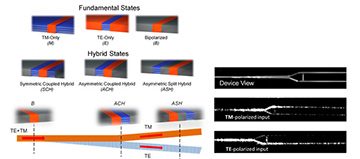 Left: Possible basic states for TAP, and how to arrange them to implement a polarization beam splitter. Right: Experimental camera images showing how the TE and TM modes are split. [Enlarge figure]
Left: Possible basic states for TAP, and how to arrange them to implement a polarization beam splitter. Right: Experimental camera images showing how the TE and TM modes are split. [Enlarge figure]
The polarization of light has been studied for more than two centuries, and most people have heard of polarized sunglasses—an 80-year-old invention. Yet engineering the polarization properties of guided waves in integrated photonic devices is not easy, as optical waveguides are not generally sensitive to polarization.
For instance, polarization-manipulative components, such as polarization beam splitters (PBSs)—a commonplace device in bulk optics—are not easily achievable in integrated photonics. To date, integrated PBSs with optical bandwidths of up to 150 nm have been achieved in the telecom band using mode-evolution in fairly complicated silicon-photonic tapered directional couplers.1 PBSs with higher optical bandwidth are challenging, due to limits imposed by multimode operation at short wavelengths and by weaker effective index contrast between polarizations at longer wavelengths.
In work over the past several years, we have established that T-shaped structures appear to have enormous single-mode, single-polarization (SMSP) bandwidths—on the order of 2.75 octaves (a 1.2-to-8.1-μm wavelength range) in silicon T-guides,2 and greater than 1.27 octaves (a 405-to-976-nm range) in silica T-guides,3 with values apparently limited only by the available measurement equipment. Such ultra-broadband SMSP operation is possible because of the high asymmetry of the T-guide geometry relative to conventional channel or ridge waveguide structures. These highly asymmetric T-guide geometries could find application in devices such as on-chip optical gyroscopes, which can suffer from noise induced by polarization fluctuations.
More recently, we have taken the idea of highly asymmetric waveguide structures further, realizing a novel approach to making polarization-sensitive integrated photonics—an approach that we call topographically anisotropic photonics (TAP). Using a damascene-patterned fabrication method,4 TAP essentially mimics the concept of bulk-optics wire-grid polarizers in an integrated-photonics setting.
We have demonstrated that, by embedding regions of anisotropic, multilayer stacks of nanometer-scale films with periodic alternating indices, as well as standard regions of isotropic media, into different configurations of waveguide core and lateral cladding materials, unique polarization-dependent behavior can be achieved over exceptionally broad bandwidths. The relevant fundamental “states” of these behaviors can be TE-only, TM-only or bipolarized, but hybrid states with symmetric and antisymmetric guiding properties are also feasible.
We have constructed polarization-selective devices by choosing a series of these states and introducing adiabatic transitions between them. We experimentally demonstrated integrated PBSs with an unprecedented bandwidth of 116 THz (0.52 octaves), insertion loss of less than 1.2 dB, and extinction ratios of greater than 16 dB using multilayer stacks of silicon dioxide and silicon nitride.4 Other demonstrated devices have included TE- and TM-pass polarizers and single-polarization microring resonators.
Researchers
Sasan Fathpour and Jeff Chiles*
CREOL, the College of Optics and Photonics, University of Central Florida, Fla., USA
*Present address: National Institute of Standards and Technology, Boulder, Colo., USA
References
1. H. Wu et al. Opt. Express 25, 6069 (2017).
2. J. Chiles and S. Fathpour. Opt. Express 24, 19337 (2016).
3. J. Chiles and S. Fathpour. Opt. Lett. 41, 3836 (2016).
4. J. Chiles et al. Opt. Express 25, 33664 (2017).

